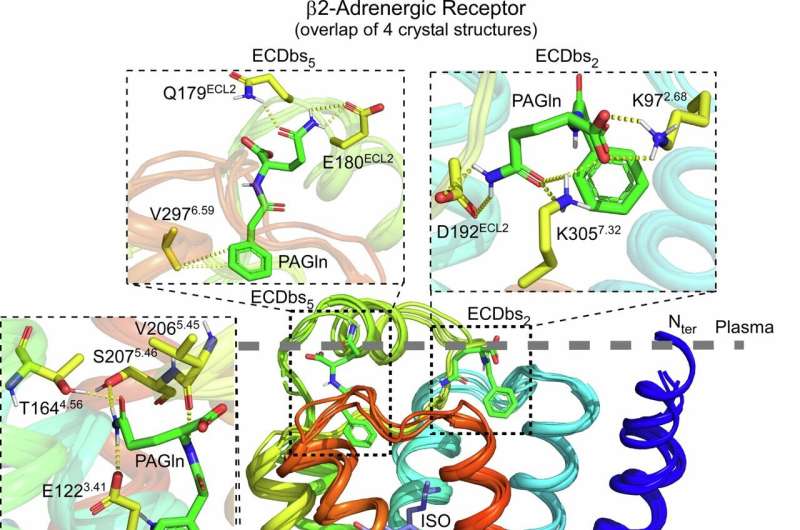This article has been reviewed according to Science X's editorial process and policies. Editors have highlighted the following attributes while ensuring the content's credibility:
fact-checked
peer-reviewed publication
trusted source
proofread
Gut microbial pathway identified as target for improved heart disease treatment

Cleveland Clinic researchers have made a significant discovery about how the gut microbiome interacts with cells to cause cardiovascular disease. The study published in Nature Communications found that phenylacetylglutamine (PAG), produced by gut bacteria as a waste product, then absorbed and formed in the liver, interacts with previously undiscovered locations on beta-2 adrenergic receptors on heart cells once it enters the circulation.
PAG was shown to interact with beta-2 adrenergic receptors to influence how forcefully the heart muscle cells contract—a process that investigators believe contributes to heart failure. Researchers showed mutating parts of the beta-2 adrenergic receptor that were previously thought to be unrelated to signaling activity in preclinical models prevented PAG from depressing the function of the receptor.
This is the latest in a series of investigations into PAG, led by Stanley Hazen, MD, Ph.D., chair of Cardiovascular and Metabolic Sciences in Cleveland Clinic's Lerner Research Institute and co-section head of Preventive Cardiology. Dr. Hazen's lab previously demonstrated that elevated circulating levels of PAG in subjects are associated with heightened risk for developing heart failure, and lead to worse outcomes for patients with heart failure.
They also showed that the gut microbial PAG signaling pathway was mechanistically linked to numerous heart failure-related features and cardiovascular disease risks. The new findings bring us one step closer to therapeutically targeting this pathway to develop an improved treatment for the prevention of heart failure, Dr. Hazen says.
Blocking beta-2 adrenergic receptors is imperfect
A commonly used heart medication for the treatment of heart failure and blood pressure called beta-blockers targets our body's "fight-or-flight" response. This critical response is controlled by beta adrenergic receptors and is fundamental to survival, but repeated instances of fight-or-flight over time can lead to chronic damage to the heart, contributing to heart failure development. Sathyamangla Prasad, Ph.D., who was a contributing author of the study, lent his expertise on beta-adrenergic receptors and heart failure to the investigation.
A standard treatment to alleviate stress on the heart is a beta-blocker medication, which works as an on/off switch for the beta-2 adrenergic receptors. To activate the fight-or-flight pathway, hormones like adrenaline bind directly into tailor-made slots in beta 2-andrenergic receptors—like a key sliding into a lock.
Beta-blockers are designed to fit into the same keyhole, preventing adrenaline and other hormones from binding to the beta-2 adrenergic receptors. This in turn causes heart rate to slow, reduces strain on the heart and opens blood vessels. Previous studies by this research team discovered that circulating PAG levels were associated with heart failure presence and indices of severity, and that PAG directly fostered heart failure-relevant features, including a weakened heartbeat. The adverse effects of PAG on heart failure-relevant features were reversed by using a common beta-blocker in pre-clinical models, reinforcing the link between PAG, heart failure and beta-adrenergic receptors.
New PAG finding offers other potential treatment options
The present studies look more deeply into determining how PAG interacts with our beta-adrenergic receptors. Prasenjit Saha, Ph.D., first author and member of Dr. Hazen's lab, mutated different areas in the beta-2 adrenergic receptor and tested whether signaling could occur with the natural hormone epinephrine (also called adrenaline). Preclinical tests showed that mutating certain locations kept the adrenaline binding site both intact and functioning, but the mutant receptor was no longer negatively regulated by PAG.
Dr. Hazen says these results indicate that beta-2 adrenergic receptors can be regulated by a second PAG binding site that acts as a custom "dimmer switch" for the adrenaline signaling pathway. Because PAG interacts with the receptor in a different location than the major hormone adrenaline, Dr. Hazen theorizes that they could be independently targeted to block harmful gut microbe-generated PAG signaling while still allowing the body's natural adrenaline signals to pass through.
Dr. Hazen says his team's findings point to an entirely new way to develop medications that regulate the beta-2 adrenergic receptor—a more nuanced regulation than what is currently on the market. They are currently working to develop drugs that target the PAG pathway and its interactions with adrenergic receptors as a new form of cardiovascular disease-treating medication.
"A beta-blocker that is more targeted in blocking the harmful signaling from the adrenergic receptors, but allowing the healthy signals through, would be an entirely new approach for treating or preventing cardiovascular disease risk," Dr. Hazen says. "This would have the potential to improve the quality of life for patients who rely on beta-blockers to calm down their body's stress responses."
More information: Prasenjit Prasad Saha et al, Gut microbe-generated phenylacetylglutamine is an endogenous allosteric modulator of β2-adrenergic receptors, Nature Communications (2024). DOI: 10.1038/s41467-024-50855-3



















